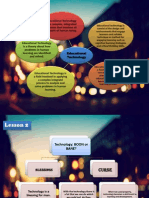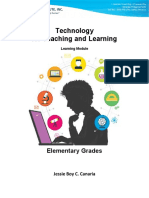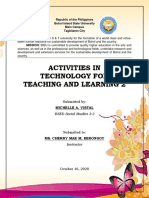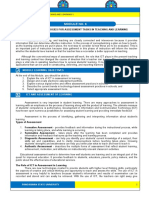TTL 2 - Module 1
TTL 2 - Module 1
Uploaded by
Kimper CabueñosCopyright:
Available Formats
TTL 2 - Module 1
TTL 2 - Module 1
Uploaded by
Kimper CabueñosOriginal Title
Copyright
Available Formats
Share this document
Did you find this document useful?
Is this content inappropriate?
Copyright:
Available Formats
TTL 2 - Module 1
TTL 2 - Module 1
Uploaded by
Kimper CabueñosCopyright:
Available Formats
MODULE 1
Learning Plans in the
Context of 21st
Century
Introduction
The basic education curriculum of the country was enhanced with the implementation
of the K to 12 Curriculum. The K to 12 Program covers Kindergarten and 12 years of basic
education (six years of elementary education, four years of Junior High School, and two years
of Senior High School [SHS] to provide sufficient time for mastery of concepts and skills,
develop lifelong learners, and prepare graduates for tertiary education, middle-level skills
development, employment, and entrepreneurship.
The implementation of the K to 12 Curriculum is expected to contribute to the country’s
development in various forms. It is believed to be necessary to improve the quality of our
education which is critical to our progress as a nation.
One of the features of the K to 12 curriculum is the requirement to equip every graduate
with the following skills:
• information, media and technology skills;
• learning and innovation skills;
• effective communication skills; and
• life and career skills
The development of these skills can be done with the aid of technologies for teaching
and learning which is the focus of this course. This course aims to present activities that will
prepare pre-service teachers to integrate ICTs in the teaching-learning processes in the various
fields of specialization. It aims to help pre-service and in-service teachers to expand the
boundaries of their creativity and that of their students beyond the four walls of the classrooms.
It aims to enable teachers to discover the power of computer technologies as teaching tools for
greater learning.
1
Module 1 – Learning Plans in the Context of the 21st Century
MUCabuenos
LESSON 1:
The K-12 Curriculum
Framework
The implementation of the K to 12 Curriculum of the Department of Education
paved the way for the enhancement of the Teacher Education Curriculum of the
Commission on Higher Education (CHED). The salient features of the K to 12
Curriculum have been thoroughly considered to ensure that all courses in the teacher education
program will meet the demands of the 21st century classrooms. One of the considerations is
the need to implement the following features of the curriculum through integrating technologies
for teaching and learning. The use of technologies is done in the different levels of learning and
in the various fields of specialization.
1. Strengthening Early Childhood Education (Universal Kindergarten)
With the Universal Kindergarten program of the Department, every Filipino child
is expected to have access to early childhood education. This access can be facilitated
using technological tools that are readily available to the school for teachers’ use.
2. Making the Curriculum Relevant to Relevant to Learners (Contextualization and
Enhancement)
Research shows that learners will value a curriculum that is relevant to their
lives. Sara Bernard (2010) stressed that students need to have a personal connection
to a lesson material that can be done through engaging them emotionally or through
connecting the information with that which they already know.
Briggs (2014) shared some few tips for making learning engaging and personally
relevant as cited by Willis, Faeth, and Immordino-Yang:
• Use suspense and keep it fresh – Drop hints about a new learning unit
before you reveal what it might be, leave gaping pauses in your speech,
change seating arrangements, and put up new and relevant posters or
displays; all these can activate emotional signals and keep student
interest piqued.
• Make it student-directed – Give students a choice of assignments on a
topic or ask them to design one of their own.
• Connect to their lives and to what they already know – Taking the time
to brainstorm about what students already know and would like to learn
about a topic helps them to create goals. This also help teachers see the
best points of departure for new ideas.
2
Module 1 – Learning Plans in the Context of the 21st Century
MUCabuenos
• Provide utility value – Utility value provides relevance first by piquing
students and by telling them the content is important to their future
goals; it then continues by showing or explaining how the content fits
into their plans in the future.
• Build relatedness – Relatedness on the other hand, answers the
question, “What have these to do with me?”. Relatedness is seen by
many as having non-academic and academic sides.
To be able to apply the tips recommended by various experts and to allow
students to realize the value of their curriculum, technological tools can be used. 21 st
century learners are expected to be demonstrating 21 st century competencies such as
collaboration, digital literacy, critical thinking, and problem solving to be able to thrive
in this world (Rich, 2014). Contextualizing the curriculum of the students for meaningful
learning poses challenges in enhancing teachers’ pedagogical skills as well as
technological skills.
3. Building Proficiency (Mother-tongue Based Multilingual Education)
To be able to promote the child’s dominant language and to use it as a language
instruction, maximum use of technological tools is highly encouraged. Currently, a lot
of teachers and schools are into developing learning materials to be able to implement
the MTB-MLE program properly especially that there is a dearth of printed and e-
materials in the mother-tongue of students.
4. Ensuring Integrated and Seamless Learning (Spiral Progression)
Learning basic concepts that lead to a more complex and sophisticated version
of the general concepts entail TPACK: Technological knowledge, pedagogical
knowledge, and content knowledge. Rediscovering concepts previously presented as
students go up in grade level will be fully supported if all the areas of specialization will
be aided by technologies for teaching and learning.
5. Gearing Up for the Future
The K to 12 Curriculum ensure college readiness by aligning the core and applied
courses to the College Readiness Standards (CRS) and the new General Education (GE)
Curriculum.
6. Nurturing the Holistically Developed Filipino (College and Livelihood readiness, 21 st
Century Skills)
To nurture holistically developed Filipino, every K to 12 graduate is expected to
be ready to go into different paths- higher education, employment, or entrepreneurship.
3
Module 1 – Learning Plans in the Context of the 21st Century
MUCabuenos
LESSON 2:
ICT- Pedagogy Integration in
Learning Plans
Teaching has always been a challenging profession since knowledge has been
expanding and essential skills have been increasing and changing. With these
challenges, teachers need to engage educational technologies to assist them in the
teaching-learning process. Engaging educational technologies in teaching are
founded on principles and philosophies. Understanding these will help you successfully
integrate technologies to allow your students to demonstrate the intended learning outcomes
of your field of specialization.
Integrating Technology in Instruction
1. John Pisapia (1994)
Integrating technology with teaching means the use of learning technologies to
introduce, reinforce, supplement, and extend skills.
2. International Society for Technology in Education (ISTE)
Effective integration of technology is achieved when students can select
technology tools to help them obtain information and present it professionally. The
technology should become an integral part of how the classroom functions- as
accessible as all other classroom tools.
3. Margaret Lloyd (2005)
ICT integration encompasses an integral part of broader curriculum reforms
which include both infrastructural as well as pedagogical considerations that are
changing not only how learning occurs but what is learned.
4. Qiyun Wang and Huay Lit Woo (2007)
ICT integration can happen in three different areas: curriculum, topic, and
lesson.
5. Bernard Bahati (2010)
The process of integrating ICT in teaching and learning must be done at both
pedagogical and technological levels with much emphasis of pedagogy.
6. UNESCO (2005)
ICT integration is not merely mastering the hardware and software skills.
4
Teachers need to realize how to organize the classroom to structure the learning tasks.
Module 1 – Learning Plans in the Context of the 21st Century
MUCabuenos
Information and Communication Technology (ICT)
The following are the definitions of ICT from various sources.
1. Moursund (2005)
ICT includes all the full range of computer hardware, computer software. And
telecommunications facilities. It also includes computerized machinery and
computerized robots.
2. Tinio (2009)
ICT is a diverse set of technological tools and resources used to communicate,
create, disseminate, store, and manage information. These technologies include
hardware devices, software applications, internet connectivity, broadcasting
technologies, and telephony.
3. UNESCO (2020)
It (ICT) is a diverse set of technological tools and resources used to transmit,
store, create, share, or exchange information. UNESCO defines it also as a scientific,
technological, and engineering discipline and management technique. ICT also refers to
handling information, its application, and association with social, economic, and cultural
matters.
4. Ratheeswari (2018)
Information Communication Technologies (ICT) influence every aspect of human
life. They play salient roles in workplaces, in business, education, and entertainment. In
this digital era, ICT is important in the classroom for giving students opportunities to
learn and apply the required the required 21st Century skills. ICT helps a teacher to
present his/her lessons attractively and enables learners to learn at any level of
educational program.
Corpuz, B.B., Lucido, P.I. (2008). Educational technology 1. Quezon City: Lorimar Publishing Inc.
Lucido, P. I. (2012). Educational technology 2. Quezon City: Lorimar Publishing Inc
Espique, F. & Ayao-ao, S. © 2020. Technology for Teaching and learning 2, Quezon City: Lorimar Publishing Inc.
5
Module 1 – Learning Plans in the Context of the 21st Century
MUCabuenos
You might also like
- Technology For Teaching and Learning 2Document131 pagesTechnology For Teaching and Learning 2Jerico O Lazado100% (6)
- Modified Ipcrf Development PlanDocument4 pagesModified Ipcrf Development PlanBong Sidlak At Liwa100% (21)
- PED 121: Technology For Teaching & Learning 2: Course ModuleDocument53 pagesPED 121: Technology For Teaching & Learning 2: Course Modulecloud beaumont100% (6)
- Technology For Teaching and Learning 1Document7 pagesTechnology For Teaching and Learning 1Ron Aranas74% (23)
- Content-Module in TTL2Document23 pagesContent-Module in TTL2babyyyyyy100% (3)
- Lesson 1 - Introduction To Technology For Teaching and LearningDocument33 pagesLesson 1 - Introduction To Technology For Teaching and LearningWisley Jay Solayao81% (16)
- Background of The StudyDocument2 pagesBackground of The StudyRowena Jumao-asNo ratings yet
- TTL 2 - Module 1Document5 pagesTTL 2 - Module 1Kimper Cabueños80% (5)
- El 3231-Technology For Teaching and Learning 2: For Language Education - EnglishDocument8 pagesEl 3231-Technology For Teaching and Learning 2: For Language Education - EnglishMarie Joy Garming100% (5)
- TTL2 - Module 7Document11 pagesTTL2 - Module 7payno gelacio100% (1)
- A Strong Partner For Sustainable DevelopmentDocument27 pagesA Strong Partner For Sustainable DevelopmentJeny Rose BedioresNo ratings yet
- Using Ict in Developing 21St Century Skills/Ict in The 21St Century SkillsDocument9 pagesUsing Ict in Developing 21St Century Skills/Ict in The 21St Century SkillsBryle Dela Torre100% (1)
- Technology For Teaching and Learning 1 Prelim Exam: Surigao Del Sur State UniversityDocument4 pagesTechnology For Teaching and Learning 1 Prelim Exam: Surigao Del Sur State UniversityRey Giansay100% (1)
- Educational Technology 2Document3 pagesEducational Technology 2Cathryn Dominique Tan100% (1)
- TTL-1-CAPULSO - Module 1 - Introduction To Technology For Teaching and LearningDocument7 pagesTTL-1-CAPULSO - Module 1 - Introduction To Technology For Teaching and LearningLeonilo B Capulso100% (2)
- TTL 2 Module 2Document2 pagesTTL 2 Module 2Kimper Cabueños75% (4)
- Technology For Teaching and Learning 1Document3 pagesTechnology For Teaching and Learning 1Rodrigo Esequille Longcop100% (2)
- Educational Technology 1 Concept MapDocument10 pagesEducational Technology 1 Concept Mapapi-264468141100% (8)
- Technology For Teaching and Learning 2Document30 pagesTechnology For Teaching and Learning 2Ricardo Dalisay75% (4)
- Technology For Teaching and Learning 1 SyllabusDocument10 pagesTechnology For Teaching and Learning 1 SyllabusEdlyn Sarmiento100% (3)
- TTL 2 Module 2Document2 pagesTTL 2 Module 2Kimper Cabueños75% (4)
- Solar System Lesson PlansDocument4 pagesSolar System Lesson Plansapi-271749569No ratings yet
- Technology For Teaching and Learning 2Document9 pagesTechnology For Teaching and Learning 2Jeneva Vistal100% (1)
- Compiled L1-2 TTL2Document18 pagesCompiled L1-2 TTL2Jay Lester UrsolinoNo ratings yet
- WEEK 1 - Learning Plans in The Context of The 21stDocument25 pagesWEEK 1 - Learning Plans in The Context of The 21stSkyNayvie100% (1)
- Ttl2 Module FinalsDocument38 pagesTtl2 Module FinalsEmerito Ramal100% (3)
- Bsed 3 Technology For Teaching and Learning 2Document2 pagesBsed 3 Technology For Teaching and Learning 2Laarni Tolete100% (1)
- TTL2 Introduction PDFDocument14 pagesTTL2 Introduction PDFNheru VeraflorNo ratings yet
- Abra State Institute of Sciences and TechnologyDocument9 pagesAbra State Institute of Sciences and TechnologyTintin Bejarin100% (3)
- Technology For Teaching and Learning: Elementary GradesDocument9 pagesTechnology For Teaching and Learning: Elementary GradesJessie CusiNo ratings yet
- Handouts Introduction To Technology For Teaching and LearningDocument3 pagesHandouts Introduction To Technology For Teaching and LearningKhemme Lapor Chu Ubial100% (3)
- Technology For Teaching and Learning 1Document8 pagesTechnology For Teaching and Learning 1Marinella Capiral100% (1)
- TTL2 Syllabus 22 23Document10 pagesTTL2 Syllabus 22 23Ferdinand Pagaran100% (1)
- Technology For Teaching and Learning-2-UNIT-1Document30 pagesTechnology For Teaching and Learning-2-UNIT-1Jude Vincent MacalosNo ratings yet
- Technology For Teaching and Learning 2Document2 pagesTechnology For Teaching and Learning 2Jay NazNo ratings yet
- ttl1 MidtermDocument62 pagesttl1 MidtermJo Michael Flores Agarma100% (1)
- Orca Share Media1603028775133 6723590003659380611Document79 pagesOrca Share Media1603028775133 6723590003659380611Charlo Vicente100% (17)
- Module in TTLDocument35 pagesModule in TTLCheskah sinangoteNo ratings yet
- Technology For Teaching and LearningDocument8 pagesTechnology For Teaching and LearningLiza Cordova Rivera100% (1)
- Module in Technology For Teaching and Learning 2 - Filipino (FM 113)Document5 pagesModule in Technology For Teaching and Learning 2 - Filipino (FM 113)Ma. Kristel Orboc0% (1)
- TTL 2 Module 1Document5 pagesTTL 2 Module 1Jessa Manatad50% (2)
- TTl2 Syllabus (Edited)Document16 pagesTTl2 Syllabus (Edited)Rebelita BejarinNo ratings yet
- Technology in Teaching and Learning MODULE 2 EDITDocument6 pagesTechnology in Teaching and Learning MODULE 2 EDITKaye Harris Salvacion60% (5)
- Unit 2 Activity - TTL 2 PDFDocument3 pagesUnit 2 Activity - TTL 2 PDFMichelle ArregLado Vistal100% (1)
- TTL 1 MODULE 5 60 PointsDocument15 pagesTTL 1 MODULE 5 60 PointsMika Virtudazo100% (1)
- Technology For Teaching and Learning: Elementary GradesDocument12 pagesTechnology For Teaching and Learning: Elementary GradesJessie Cusi100% (2)
- Technology For Teaching and LearningDocument17 pagesTechnology For Teaching and LearningMa. Kristel Orboc100% (1)
- Technology For Teaching and Learning 2 Second SemesterDocument35 pagesTechnology For Teaching and Learning 2 Second SemesterKimboy Gentapanan100% (1)
- Midterm Exam in TTL 1Document6 pagesMidterm Exam in TTL 1Junelyn Gapuz VillarNo ratings yet
- Unit 3: Theories and Principles in The Use and Design of Technology Driven Learning LessonsDocument5 pagesUnit 3: Theories and Principles in The Use and Design of Technology Driven Learning Lessons서재배No ratings yet
- Lesson 1 Technology For Teaching and Learning 2: An OverviewDocument6 pagesLesson 1 Technology For Teaching and Learning 2: An OverviewJhoyz GadonNo ratings yet
- OBTLDocument5 pagesOBTLHyman Jay Blanco100% (1)
- Unit III Productivity Software ApplicationTools For Teaching and Learning RevDocument15 pagesUnit III Productivity Software ApplicationTools For Teaching and Learning RevMarifi Peningolo100% (1)
- Compilation of Activities: TTL2-Technology For Teaching and Learning 2Document30 pagesCompilation of Activities: TTL2-Technology For Teaching and Learning 2Happy Sweet Casas100% (1)
- Pame Marvin - BSE3A Social Studies.: Technology in Teaching 2Document2 pagesPame Marvin - BSE3A Social Studies.: Technology in Teaching 2MarvinbautistaNo ratings yet
- Edtech 1 MidtermsDocument4 pagesEdtech 1 MidtermsTintin Bejarin100% (3)
- TTL 1 MODULE 6 20 PointsDocument7 pagesTTL 1 MODULE 6 20 PointsDesiree Matabang100% (1)
- TTL 1 Midterm Quiz 1Document4 pagesTTL 1 Midterm Quiz 1Charisse Reyjenie Molina PobletinNo ratings yet
- TTL 1 Module 5 60 PointsDocument16 pagesTTL 1 Module 5 60 PointsDesiree Matabang100% (3)
- Module 1 TTL2Document4 pagesModule 1 TTL2Neslene BangngonNo ratings yet
- MODULE 1 - Learning Plans in The Context of The 21st CenturyDocument7 pagesMODULE 1 - Learning Plans in The Context of The 21st CenturyNiña Edrienne JuntillaNo ratings yet
- Equal Opportunity of Quality Education For All Through Flexible Learning Strategies.Document20 pagesEqual Opportunity of Quality Education For All Through Flexible Learning Strategies.AlTrigunNo ratings yet
- Technology For Teaching and Learning 2Document8 pagesTechnology For Teaching and Learning 2Jamaica TemblorNo ratings yet
- Group 1Document5 pagesGroup 1ewolramnasomitelimusNo ratings yet
- Instructional Design Models and Theories: Inquiry-Based Learning ModelDocument2 pagesInstructional Design Models and Theories: Inquiry-Based Learning ModelKimper Cabueños100% (1)
- Social Studies Teaching Resources in The 21ST CenturyDocument7 pagesSocial Studies Teaching Resources in The 21ST CenturyKimper Cabueños100% (1)
- Multiple Intelligences SurveyDocument5 pagesMultiple Intelligences SurveyKimper CabueñosNo ratings yet
- Common & Proper NounsDocument2 pagesCommon & Proper NounsKimper CabueñosNo ratings yet
- Counters For Mass NounsDocument1 pageCounters For Mass NounsKimper CabueñosNo ratings yet
- Prof - Ed 107 Facilitating LearningDocument2 pagesProf - Ed 107 Facilitating LearningKimper CabueñosNo ratings yet
- 03d Training Needs Survey Teaching Staff With Managerial Function Rev.01 1Document4 pages03d Training Needs Survey Teaching Staff With Managerial Function Rev.01 1Kimper CabueñosNo ratings yet
- Class Schedule Class Schedule Class ScheduleDocument1 pageClass Schedule Class Schedule Class ScheduleKimper CabueñosNo ratings yet
- Name of Teacher: School: School Year: QuarterDocument2 pagesName of Teacher: School: School Year: QuarterRachel AmanteNo ratings yet
- Final Practicum Report Andersen Casey Year 5 Bed May 2020Document4 pagesFinal Practicum Report Andersen Casey Year 5 Bed May 2020api-511866902No ratings yet
- Prof Ed 3Document28 pagesProf Ed 3HTCCS BatoCamSur100% (2)
- Andrea Brown - Resume - 2023Document2 pagesAndrea Brown - Resume - 2023api-663101658No ratings yet
- Five - Month Lac Plan 2024-25Document4 pagesFive - Month Lac Plan 2024-25Marilyn ManatoNo ratings yet
- October 17 2ND Periodical ExamDocument2 pagesOctober 17 2ND Periodical ExamARVEE DAVE GIPANo ratings yet
- Coil Vessel RubricDocument1 pageCoil Vessel Rubricapi-240769329No ratings yet
- Greater Than or Less ThanDocument8 pagesGreater Than or Less Thanapi-276656028100% (1)
- Artifact Examples For TeachersDocument2 pagesArtifact Examples For TeachersJanett PenaililloNo ratings yet
- Mfano Wa Lesson Plan Kutoka Kwenye MfumoDocument1 pageMfano Wa Lesson Plan Kutoka Kwenye MfumoArone JohnsonNo ratings yet
- Frank McCourt HS Vision StatementDocument2 pagesFrank McCourt HS Vision StatementGothamSchools.orgNo ratings yet
- Data Gathering Instrument For Trainee's CharacteristicsDocument3 pagesData Gathering Instrument For Trainee's CharacteristicsRaymond PacaldoNo ratings yet
- Araling Panlipunan Department: Topic: Applied Knowledge of Content Within and Across Curriculum Teaching AreasDocument34 pagesAraling Panlipunan Department: Topic: Applied Knowledge of Content Within and Across Curriculum Teaching AreasAsianheart Francisco KhajarNo ratings yet
- Kelly Murrays ResumeDocument2 pagesKelly Murrays Resumeapi-273349792No ratings yet
- A Window To CLILDocument43 pagesA Window To CLILSussanRooNo ratings yet
- Lesson 4 Year 9 HassDocument2 pagesLesson 4 Year 9 Hassapi-496451435No ratings yet
- E-Perancangan Rekod Mengajar (e-PREMA)Document2 pagesE-Perancangan Rekod Mengajar (e-PREMA)g-08112623No ratings yet
- LAC Narrative ReportDocument3 pagesLAC Narrative ReportMarvzkie Zeramla YnohtnaNo ratings yet
- Daily Lesson PlanDocument2 pagesDaily Lesson PlanRezzie Bryan YbañezNo ratings yet
- Writing Your Own Teaching PhilosophyDocument4 pagesWriting Your Own Teaching PhilosophyJuan Camilo Galeano SánchezNo ratings yet
- School PoliciesDocument3 pagesSchool PoliciesRemar PabalayNo ratings yet
- Lesson Plan: First Observation (MST)Document5 pagesLesson Plan: First Observation (MST)api-329103312No ratings yet
- Students Life. CollocationsDocument3 pagesStudents Life. CollocationsjesusminajNo ratings yet
- Unit 1Document11 pagesUnit 1Richella BorromeoNo ratings yet
- 5E Model For Leson Plan PreparationDocument21 pages5E Model For Leson Plan PreparationOrigen Peralta AccadNo ratings yet
- How Many Toys in The Tub PDFDocument14 pagesHow Many Toys in The Tub PDFLaksNo ratings yet
- CDC Lesson PlanDocument2 pagesCDC Lesson Planapi-278899878No ratings yet

































































































